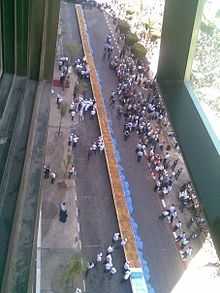Kanafeh
| Kanafeh | |
|---|---|
|
Turkish künefe from Hatay | |
| Type | Dessert |
|
| |
Kenafeh (Arabic: كنافة kunāfah, Turkish: künefe, Azerbaijani: Riştə Xətayi / ریشته ختایی, Greek: κα(ν)ταΐφι kadaïfi/kataïfi), also spelled knafeh, Kunafeh, kunafeh, knafeh, or kunafah) is a Levantine cheese pastry soaked in sweet sugar-based syrup, typical of the regions belonging to the former Ottoman Empire.[1] It is a dessert specialty of the Levant, especially in Lebanon, Jordan, the Palestinian territories, Israel, Syria and northern Egypt. It is a first cousin of the Greek kadaifi and the Turkish tel kadayıf, künefe and ekmek kadayıfı. [2]
Preparation

Kanafeh pastry comes in three types:
- khishnah (Arabic خشنه) (rough): crust made from long thin noodle threads
- na'ama (Arabic ناعمة) (fine): semolina dough
- mhayara (Arabic محيرة) (mixed): a mixture of khishnah and na'ama
The pastry is heated in butter, margarine, or palm oil, then spread with soft white cheese, such as Nabulsi cheese, and topped with more pastry. In khishnah kanafeh the cheese is rolled in the pastry. A thick syrup of sugar, water, and a few drops of rose water or orange blossom water is poured on the pastry during the final minutes of cooking. Often the top layer of pastry is tinted with orange food coloring. Crushed pistachios are sprinkled on top as a garnish.
Variants
Ka'ket Kanafeh

This variant is popular across the Levant and Turkey, where it can be eaten for breakfast, though it is primarily considered a dessert. Eaten as a sweet or helwah, it may also be placed in a special flat bread and sprinkled with sesame seeds. It is traditionally served alongside, or drenched in, a thick, sugar-based, honey-based, or glucose-based syrup called qattar or attar.
The city of Nablus is especially renowned for its kanafeh.[3]
Kadayıf and künefe
The Turkish variant of the pastry kanafeh is called künefe and the wirey shreds are called tel kadayıf. A semi-soft cheese such as Urfa peyniri (cheese of Urfa, or Hatay peyniri, cheese of Hatay), made of raw milk, is used in the filling.[4][5] In making the künefe, the kadayıf is not rolled around the cheese; instead, cheese is put in between two layers of wiry kadayıf. It is cooked in small copper plates, and then served very hot in syrup with clotted cream (kaymak) and topped with pistachios or walnuts. In the Turkish cuisine, there is also yassı kadayıf and ekmek kadayıfı, none of which is made of wirey shreds.
Riştə Xətayi
This type of Azerbaijanian variant is prepared in Tabriz, Iran. «Riştə Xətayi» is called to mesh shreds that are cooked typically in Ramadan in the world's biggest covered Bazaar of Tabriz. It is made of chopped walnuts, cinnamon, ginger, powder of rose, sugar, water, rose water, olive oil.[6][7]
Kadaif

In this variant, called also καταΐφι or κανταΐφι in Greek (kataïfi or kadaïfi), the threads are used to make pastries of various forms (tubes or nests), often with a filling of chopped nuts as in baklava.
A kadaif pastry is made by putting down a layer of wire kadaif, then a layer of a filling of chopped nuts, then another layer of wire kadaif. The pastries are painted with melted butter, baked until golden brown, then drenched in sugar or honey syrup.[8]
Kanafeh in Jerusalem

Jerusalem kanafeh is a neon orange pastry with a crust of shredded phyllo dough or semolina filled with soft goat cheese and drenched in syrup. It is especially popular during Ramadan.
World records
The largest plate of kanafeh was made in Nablus[9] in an attempt to win a Palestinian citation in the Guinness World Records. It measured 75×2 meters and weighed 1,350 kilograms.
See also
- Ekmek kadayıfı, Turkish bread custard
- Phyllo
- Qatayef, a dumpling-like confection involving some of the same ingredients
References
- ↑ Albala, K. (2011). Food Cultures of the World Encyclopedia 1. Greenwood. p. 311. ISBN 9780313376269. Retrieved 2014-12-02.
- ↑ Kunafah-kenefeh
- ↑ Cuisine Institute for Middle East Understanding
- ↑ http://www.politikcity.de/forum/internationale-k%FCche-d%FCnyanin-mutfa/19192-k%FCnefe.html
- ↑ "Künefe – ein außergewöhnliches Dessert". nobelio.de. Retrieved 2014-12-02.
- ↑ Behnegarsoft.com. "اهراب نیوز - تصویری/ رشته ختایی؛ شیرینی مخصوص تبریز برای رمضان". ahrabnews.com. Retrieved 2014-12-02.
- ↑ "تصاویر/شيريني مخصوص رمضان در تبريز - مشرق نیوز | mashreghnews.ir". mashreghnews.ir. Retrieved 2014-12-02.
- ↑ "Kadaif | Kuhar.ba - Hrana, recepti, zdravlje". kuhar.ba. Retrieved 2014-12-02.
- ↑ WEST BANK: Palestinian Knafeh enters Guinness World Records.
